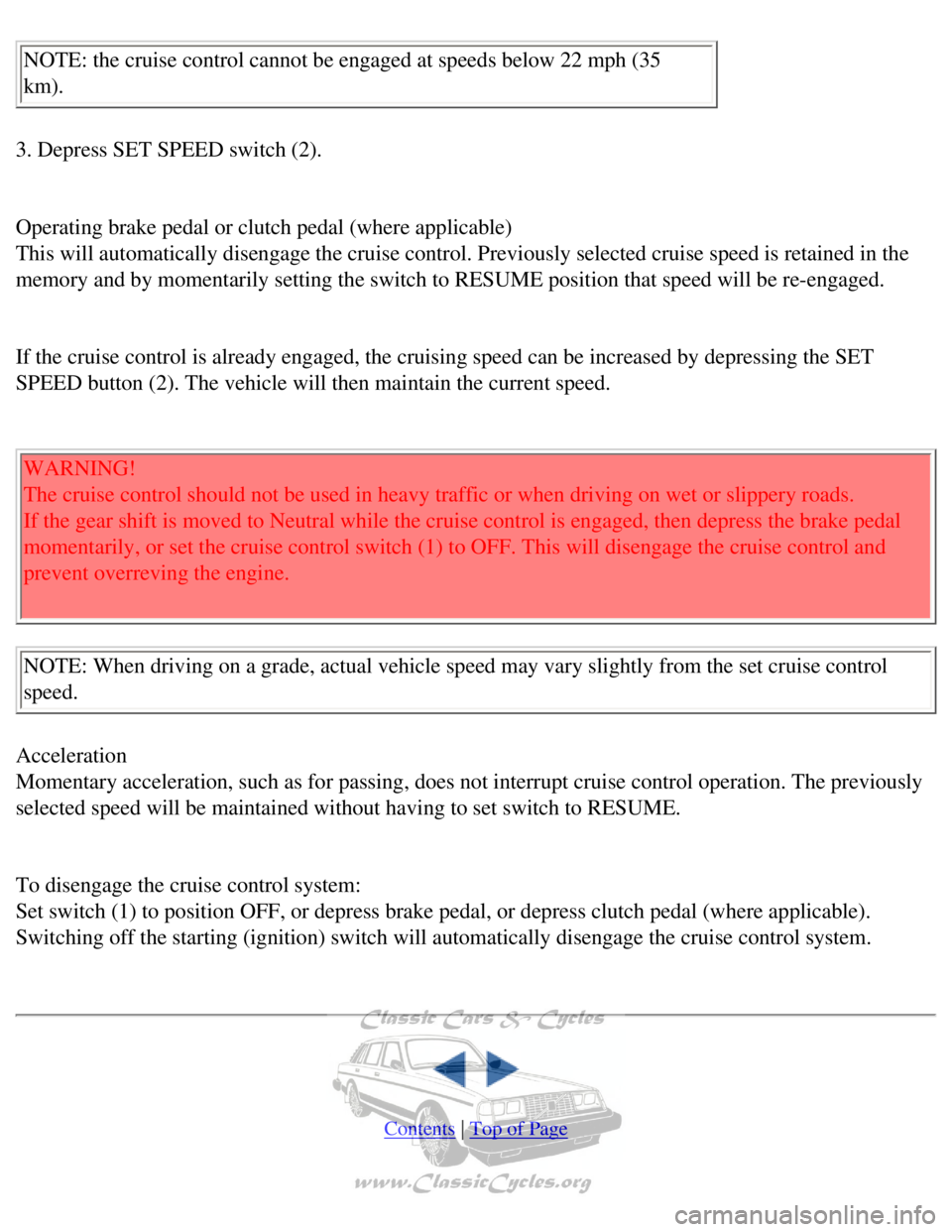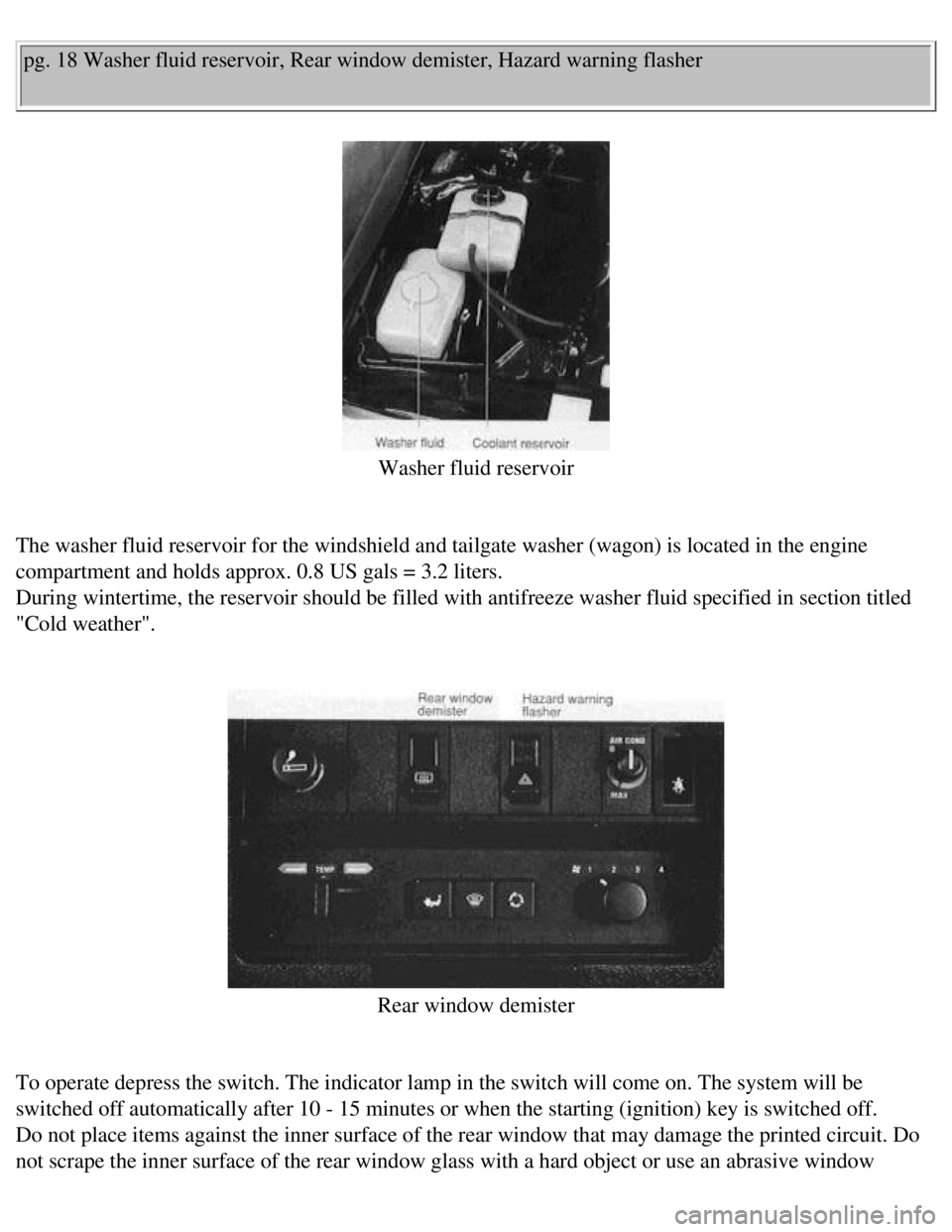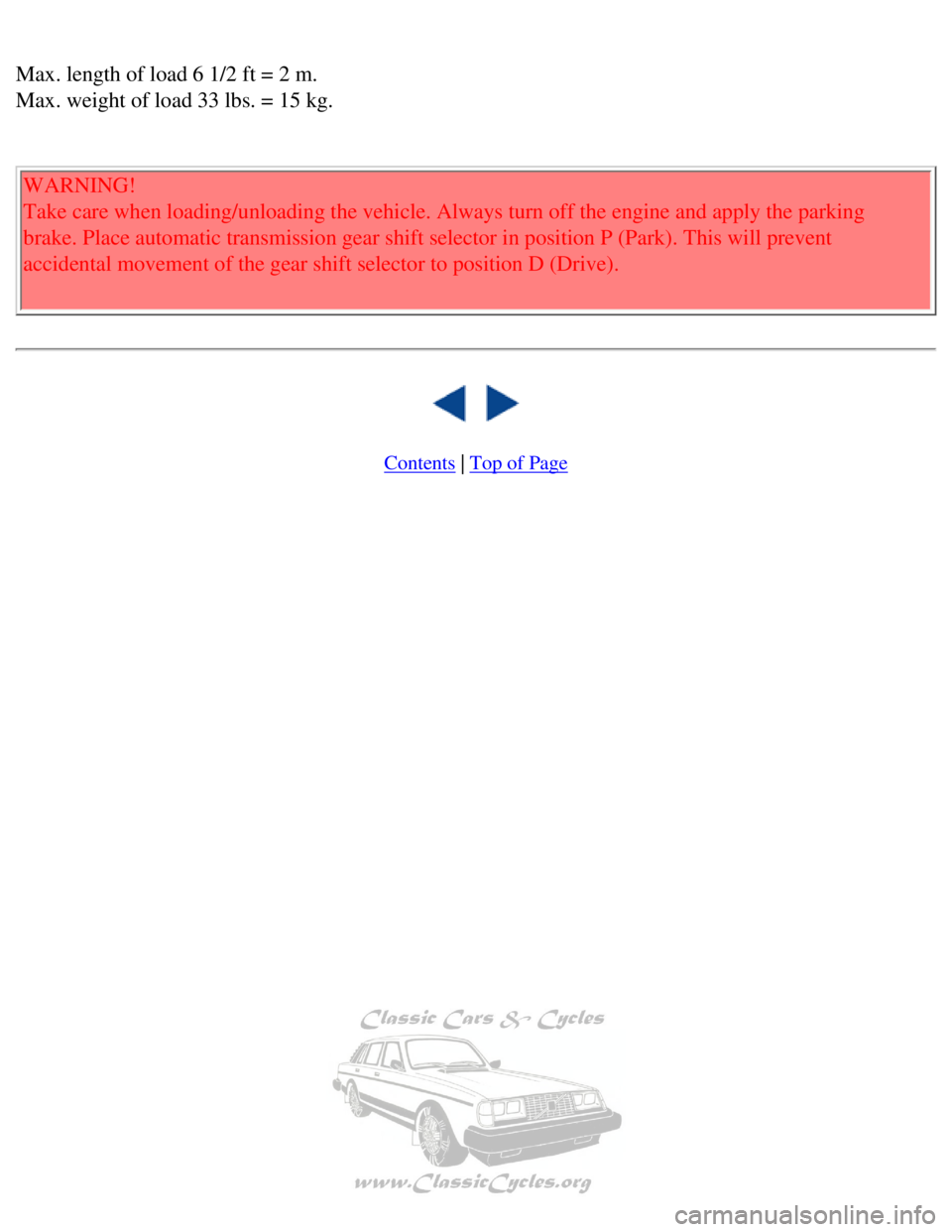1990 VOLVO 240 engine
[x] Cancel search: enginePage 20 of 143

Volvo 1990 240 Model
NOTE: the cruise control cannot be engaged at speeds below 22 mph (35
km).
3. Depress SET SPEED switch (2).
Operating brake pedal or clutch pedal (where applicable)
This will automatically disengage the cruise control. Previously selecte\
d cruise speed is retained in the
memory and by momentarily setting the switch to RESUME position that spe\
ed will be re-engaged.
If the cruise control is already engaged, the cruising speed can be incr\
eased by depressing the SET
SPEED button (2). The vehicle will then maintain the current speed.
WARNING!
The cruise control should not be used in heavy traffic or when driving o\
n wet or slippery roads.
If the gear shift is moved to Neutral while the cruise control is engage\
d, then depress the brake pedal
momentarily, or set the cruise control switch (1) to OFF. This will di\
sengage the cruise control and
prevent overreving the engine.
NOTE: When driving on a grade, actual vehicle speed may vary slightly fr\
om the set cruise control
speed.
Acceleration
Momentary acceleration, such as for passing, does not interrupt cruise c\
ontrol operation. The previously
selected speed will be maintained without having to set switch to RESUME\
.
To disengage the cruise control system:
Set switch (1) to position OFF, or depress brake pedal, or depress clu\
tch pedal (where applicable).
Switching off the starting (ignition) switch will automatically diseng\
age the cruise control system.
Contents | Top of Page
file:///K|/ownersdocs/1990/1990_240/90240_03.htm (7 of 7)12/30/2006 8:\
25:02 AM
Page 21 of 143

Volvo 1990 240 Model
pg. 18 Washer fluid reservoir, Rear window demister, Hazard warning flas\
her
Washer fluid reservoir
The washer fluid reservoir for the windshield and tailgate washer (wago\
n) is located in the engine
compartment and holds approx. 0.8 US gals = 3.2 liters.
During wintertime, the reservoir should be filled with antifreeze washer\
fluid specified in section titled
"Cold weather".
Rear window demister
To operate depress the switch. The indicator lamp in the switch will com\
e on. The system will be
switched off automatically after 10 - 15 minutes or when the starting (\
ignition) key is switched off.
Do not place items against the inner surface of the rear window that may\
damage the printed circuit. Do
not scrape the inner surface of the rear window glass with a hard object\
or use an abrasive window
file:///K|/ownersdocs/1990/1990_240/90240_04.htm (1 of 5)12/30/2006 8:\
25:02 AM
Page 39 of 143

Volvo 1990 240 Model
A self-diagnostic system incorporated in the sensor monitors the SRS. If\
a fault is detected, the "SRS"
warning light will illuminate. the light is included in the warning/indi\
cator light cluster in the instrument
panel. Normally, the SRS warning light will be illuminated along with th\
e other warning/indicator lights
when the ignition key is turned to the ON position (position II), and \
go out a short time after the engine
has been started. Check that this light is functioning properly every ti\
me the car is started.
The following items are monitored by the diagnostic system:
l Sensor unit electronics integrity.
l Reserve energy supply.
l Diagnostic output circuit.
l System voltage.
l Integrity of system connectors.
l Mercury switch closure.
l Gas generator ignitor
WARNING! If the SRS warning light stays on after the engine has started \
or if it comes on while you
are driving, drive the car to the nearest authorized Volvo Dealer for in\
spection as soon as possible.
ATTENTION! SRS VEHICLE!
THIS CAR IS EQUIPPED WITH A SUPPLEMENTAL RESTRAINT SYSTEM. TO PROVIDE
CONTINUED RELIABILITY, CERTAIN ELEMENTS OF THE SUPPLEMENTAL RESTRAINT
SYSTEM SHALL BE SERVICED OR REPLACED BY 1999. SEE OWNERS MANUAL FOR
FURTHER INFORMATION.
VOLVO
There is no maintenance to perform on the SRS yourself. The only periodi\
c maintenance recommended
on the SRS is that the air bag module and the sensor unit should be repl\
aced every ten years and that the
other components in the system (wiring, connectors, etc.) should also \
be inspected at this time. This
service must be performed by an authorized Volvo dealer.
file:///K|/ownersdocs/1990/1990_240/90240_06.htm (8 of 9)12/30/2006 8:\
25:04 AM
Page 46 of 143

Volvo 1990 240 Model
Max. length of load 6 1/2 ft = 2 m.
Max. weight of load 33 lbs. = 15 kg.
WARNING!
Take care when loading/unloading the vehicle. Always turn off the engine\
and apply the parking
brake. Place automatic transmission gear shift selector in position P (\
Park). This will prevent
accidental movement of the gear shift selector to position D (Drive). \
Contents | Top of Page
file:///K|/ownersdocs/1990/1990_240/90240_07.htm (6 of 6)12/30/2006 8:\
25:04 AM
Page 51 of 143

Volvo 1990 240 Model
pg. 41 Operating the car
42Service inspection
42Break-in period
43Driving economy, shift indicator light
44Starting the engine
45Manual transmission
46Automatic transmission
48Emergency towing
49Towing information
50Trailer hauling
51Automatic transmission, brake system
52Catalytic converter
pg. 42 Break-in period, Service inspection
A new car should be broken-in!
Manual transmission
During the break-in period do not exceed the following speeds*:
First 600 miles (1,000 km)
1st gear 20
mph
(30 km/h)
2nd
gear 30
mph
(50 km/h)
file:///K|/ownersdocs/1990/1990_240/90240_09.htm (1 of 6)12/30/2006 8:\
25:05 AM
Page 53 of 143

Volvo 1990 240 Model
To obtain best parking brake performance, the brake linings should be br\
oken in.
Stop 5-7 times from 30 mph (50 km/h), transmission in neutral, applyin\
g the parking brake with the
release button pressed in during the stop. The force must not lock the r\
ear wheels. If this happens,
release the brake enough to let the wheels rotate. Drive a mile between \
each stop to cool the brakes.
Check for proper parking brake operation.
Note: The brake lights are not illuminated when applying the parking bra\
ke. To warn traffic from
behind it is therefore advisable to depress the brake pedal slightly to \
illuminate the brake lights.
600 - 1,200 mile maintenance service
To ensure proper operation the car should be taken to a Volvo dealer bet\
ween the first 600 - 1,200 miles
(1,000 - 2,000 km) for a maintenance service. The oil in the engine, m\
anual transmission and rear axle
will then be changed. This is very important since the oil rapidly colle\
cts impurities during the break-in
period.
pg. 43 Driving economy, Shift indicator light
Economical driving does not necessarily mean driving slowly
Better driving economy may be obtained by thinking ahead, avoiding rapid\
starts and stops and
adjusting the speed of your vehicle to immediate traffic conditions. Obs\
erve the following rules:
l Bring the engine to normal operating temperature as soon as possible by \
driving with a light foot on
the accelerator pedal instead of allowing the engine to idle for a prolo\
nged period. A cold engine uses
more fuel and is subject to increased wear.
l When possible avoid using the car for driving short distances. This does\
not allow the engine to reach
normal operating temperature.
l Drive carefully and avoid rapid acceleration and hard braking.
l Do not exceed speed limit.
l Avoid carrying unnecessary items (extra load) in the car.
l Check tire pressures regularly (cold tires).
l Remove snow tires when threat of snow or ice has ended.
l Note that roof racks, ski racks, etc., increase air resistance and there\
by fuel consumption.
file:///K|/ownersdocs/1990/1990_240/90240_09.htm (3 of 6)12/30/2006 8:\
25:05 AM
Page 54 of 143

Volvo 1990 240 Model
l Avoid using automatic transmission kick-down feature unless necessary.
Other factors which decrease gas mileage are:
l Worn or dirty spark plugs
l Incorrect spark plug gap
l Dirty air filter
l Incorrect valve clearance
l Incorrect idle speed
l Dirty engine oil and clogged oil filter
l Dragging brakes
l Incorrect front end alignment
l Low tire pressure
Shift indicator light
(manual transmission models only)
The Volvo shift indicator light (S.I.L.) is a device designed to help \
you get even better gas mileage from
your Volvo car. Studies have shown that the best fuel economy is obtaine\
d by shifting gears at low
engine rpm and high relative engine load. The Volvo S.I.L. is calibrated\
to show you when to shift for
improved mileage without sacrificing smooth acceleration .
Use of the S.I.L. is simple. Shift to next higher gear as soon as the li\
ght comes on. You may find after
using the S.I.L. for some time that your natural shifting rhythm will ad\
apt to the S.I.L.'s suggestion.
Some drivers may even shift before the light comes on.
Obviously, there will be times when you need to shift later than the lig\
ht would indicate (for example,
when climbing hills or trailer towing). Using the light regularly, howe\
ver, should result in a mileage
improvement of six percent or more, depending on how you normally drive.\
Programming instructions for shift indicator
If the current supply to the control unit is cut (battery disconnected)\
, the control unit will have to be re-
programmed as the control unit memory will be erased.
Drive the car in each gear (first gear not necessary) for approximatel\
y 8 seconds.
The gear change indicator light will flicker once (0.5 seconds), as ea\
ch gear is programmed.
file:///K|/ownersdocs/1990/1990_240/90240_09.htm (4 of 6)12/30/2006 8:\
25:05 AM
Page 55 of 143

Volvo 1990 240 Model
Note: Remove foot completely from the clutch pedal after each gear chang\
e when programming the
control unit.
pg. 44 Starting the engine
To start the engine;
1 Enter the car and check that the seat is adjusted properly. Make sure \
that the brake (and clutch) pedal
can be depressed completely. Move the seat closer if necessary.
2 Fasten the seat belt.
3 Apply the parking brake if not already set. Depress the brake pedal wi\
th your right foot.
4 Place the gear selector lever in neutral (position N or P, automatic \
transmission).
5 Depress the clutch pedal (manual transmission).
6 Without touching the accelerator pedal turn the ignition key to starti\
ng position. Release the key as
soon as the engine starts.
Avoid repeated short attempts to start (fuel is injected every time the\
starter is engaged when engine is
cold).
Allow the starter to operate for a longer time (but not more than 15-20\
seconds).
Do not race a cold engine immediately starting.
Engine warm-up-initial driving procedure
Experience shows that engines in vehicles driven short distances are sub\
ject to abnormally rapid wear
because the engine never reaches normal operating temperature.
It is therefore beneficial to reach normal operating temperature as soon\
as possible by driving with a
light foot on the accelerator pedal.
Warning: Always open the garage doors fully before starting the engine i\
nside the garage to ensure
adequate ventilation. The exhaust gases contain carbon monoxide, which i\
s invisible and odorless but
very poisonous.
file:///K|/ownersdocs/1990/1990_240/90240_09.htm (5 of 6)12/30/2006 8:\
25:05 AM